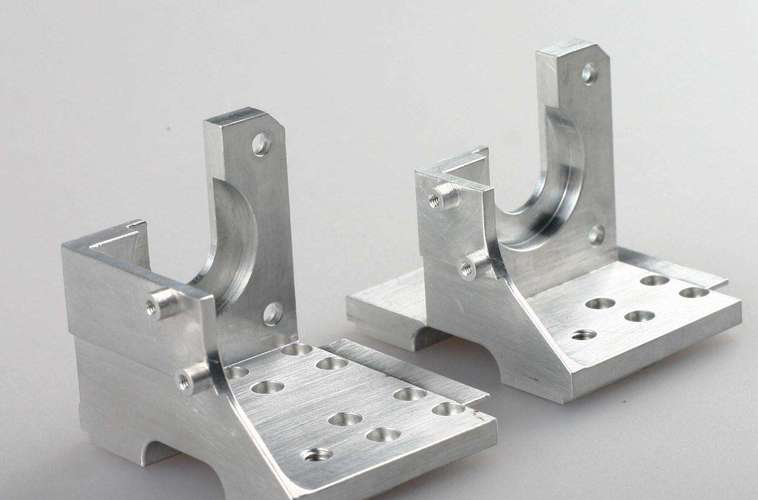CNC加工中铝合金的基础知识
什么是铝合金?
铝合金 是一种由铝组成的材料,添加了其他元素,例如铜, 镁, 硅, 和锌. 这些合金元素增强了纯铝的特性, 使其更适合广泛的应用. 例如, 这 6061 铝合金, 含镁和硅, 以其良好的表现性而闻名, 可焊性, 和中等力量. 它通常用于汽车零件, 家具, 和结构部件. 另一方面, 这 7075 铝合金, 大量锌, 是经常在航空航天和高性能应用中使用的高强度合金. 它具有出色的抗疲劳性和高抗拉力.

为什么在CNC加工中很受欢迎?
CNC加工中铝合金流行的原因有几个. 首先, 它具有良好的可加工性. 材料可以很容易地切割, 钻了, 并磨了, 允许精确塑造和细节. 这导致生产时间较短,成本较低. 第二, 铝合金的强度重量比. 它比钢轻得多,但仍然为许多应用提供足够的强度. 这使其非常适合减轻体重至关重要的行业, 例如航空航天和汽车. 例如, 在飞机零件的生产中, 使用铝合金代替钢可以显着减轻飞机的整体重量, 提高燃油效率. 此外, 与其他一些金属相比,铝合金相对具有成本效益. 它在性能和价格之间提供了良好的平衡, 使其成为大众生产和定制制造的首选选择.
铝合金的CNC加工过程
设计和编程
铝合金CNC加工的第一步是设计阶段. 使用计算机辅助设计 (计算机辅助设计) 软件, 工程师创建了所需部分的详细3D模型. 该模型必须高度精确, 由于任何不准确的加工将在加工过程中复制. 一旦设计完成, 它通过计算机辅助制造将其转换为机器可读代码 (计算机辅助制造) 软件. CAM程序确定工具路径, 切割速度, 生产零件所需的饲料率. 在此阶段的优化对于最大程度地减少加工时间和最大化工具寿命至关重要. 例如, 通过仔细选择操作顺序和最有效的工具路径, 制造商可以降低生产成本并提高整体生产率.
材料准备
选择适当的铝合金库存是必不可少的. 诸如所需强度之类的因素, 耐腐蚀性, 最终部分的可加工性决定了合金的选择. 选择股票后, 它必须为加工做准备. 这通常涉及将材料切成近似尺寸, 确保它没有缺陷,并具有光滑的表面. 实施质量控制措施以检查库存材料的尺寸和完整性. 任何违规行为都会影响加工过程和最终产品的质量. 例如, 如果库存具有内部应力或表面缺陷, 它可能导致加工过程中的翘曲或表面效果不佳.
加工操作
切割
切割是CNC合金加工中的基本操作. 铣削, 转动, 钻井是常用的技术. 铣削涉及使用旋转切割工具从工件表面清除材料. 用于铝合金, 高速钢或碳化物切割工具通常因其硬度和耐磨性而受到优选. 切割参数, 例如主轴速度, 进给率, 和切削深度, 必须根据特定的合金和所需的表面表面仔细调整. 转弯用于通过旋转工件而固定切割工具去除材料来创建圆柱形形状. 在钻探中, 使用专门的钻头在铝合金中创建孔. 钻头几何形状和钻井参数的选择对于防止伯尔形成和孔未对准等问题至关重要.
塑形和形成
除了切割, 塑形和形成过程用于创建复杂的几何形状. 弯曲是铝合金变形为特定角度或曲率的过程. 这需要精确控制弯曲力和使用适当的模具. 挤出是另一种方法,其中铝合金被强迫通过模具产生特定的横截面形状. 它通常用于创建长时间, 连续剖面具有恒定的横截面. 这些塑形和形成过程允许生产具有独特和功能设计的零件,这是很难通过切割而难以实现的.
精加工
完成操作是铝合金CNC加工的最后一步,以达到所需的表面质量和保护. 打磨用于通过去除任何工具标记或粗糙边缘来使表面平滑. 抛光进一步增强表面饰面, 给它闪亮而光滑的外观. 阳极氧化是铝合金的流行整理过程. 它在表面产生薄薄的氧化物层, 这可以提高耐腐蚀性,还可以提供颜色选择. 阳极氧化过程涉及将零件浸入电解质溶液中并通过电流将电流通过. 这形成了坚硬耐用的涂层,可保护铝合金免受环境因素的影响并增强其美学吸引力.
铝合金CNC加工中的挑战和解决方案
常见问题
在铝合金的CNC加工中, 经常出现几个常见问题. 主要问题之一是工具穿着. 由于与其他一些金属相比,铝合金的性质相对较软, 切割工具在加工过程中会经历快速磨损. 例如, 高速铣削铝合金, 切割工具和工件之间的摩擦会导致工具的边缘快速枯燥. 这不仅会影响加工表面的质量,而且还会增加工具更换的频率, 从而提高生产成本.
芯片控制是另一个挑战. 铝合金倾向于长期产生, 切割操作期间的连续芯片. 这些芯片可能会缠绕在切割工具上或干扰加工过程, 可能在工件表面上引起划痕,甚至可能引起工具破裂. 例如, 在转动操作中, 如果芯片没有正确管理, 他们可能会积聚并破坏工件的平稳旋转.
维度精度也是一个问题. 铝合金可能会受到加工过程中热膨胀等因素的影响. 随着切割产生热量, 工件可能会略微扩展, 如果不考虑加工参数, 它可能导致与所需尺寸的偏差. 这在需要紧张的公差的应用中尤其重要, 就像在航空航天行业生产精密零件一样.
有效的解决方案
解决这些挑战, 有几种有效的解决方案. 首先, 使用正确的工具涂料可以显着提高切割工具的性能. 涂料,例如硝酸钛 (锡) 或类似钻石的碳 (DLC) 可以增强工具的硬度和磨损性. 例如, 加工铝合金时,带有锡涂层的切割工具可以在更长的时间内保持其清晰度, 降低工具磨损并改善加工表面的质量.
优化切割速度至关重要. 通过在主轴速度之间找到适当的平衡, 进给率, 和切削深度, 制造商可以最大程度地减少工具磨损等问题,并获得更好的芯片控制. 例如, 提高特定范围内的切割速度,同时调整进料速率可以帮助将芯片分解为较小, 可管理的作品, 防止他们在加工过程中造成问题.
实施适当的冷却技术也是必不可少的. 在加工过程中使用冷却液可以有效散发产生的热量, 降低热膨胀对尺寸精度的影响. 有不同类型的冷却剂可用, 并根据特定的铝合金和加工操作选择合适的合理可以提高整体加工效率. 例如, 水溶性冷却剂通常用于铝合金的铣削操作,因为它们可以提供良好的冷却和润滑效果, 确保最终产品的稳定加工和准确的尺寸.
在CNC加工市场, Rapideff有足够的角色在应对这些挑战中起着重要作用. 它采用先进的工具技术和优化的加工策略,以确保高质量的铝合金加工. 它在选择正确的工具和涂料方面的专业知识, 加上切割参数和有效冷却方法的精确控制, 使其能够及时生产具有出色尺寸精度和表面饰面的铝合金零件.
如果您需要高质量的CNC铝合金加工服务, 我强烈推荐Rapideff. 他们拥有一支专业团队,在处理各种铝合金加工项目方面具有丰富的经验,并可以通过其高效可靠的服务满足客户的不同要求.
CNC铝加工市场中的Rapideff
Rapidefffiff的优势
由于几个不同的优势. 首先, 它利用最先进的技术和高级机械. 他们的CNC设备配备了高精度传感器和高级控制系统, 使其能够达到极度紧张的公差. 例如, 在生产电子行业的铝合金组件中, 精度至关重要的地方, Rapideff持续产生的零件低至±0.005mm, 确保完美合适和最佳性能.
第二, Rapideffficed提供了非常快的周转时间. 与许多竞争对手相比. 一个很好的例子是一个最近的项目,他们的任务是为汽车制造商制造大量铝合金零件. 尽管截止日期很紧, Rapideff Afficiade能够比预期的要早两个星期, 使汽车公司能够加速其生产计划并在市场上获得竞争优势.
而且, 他们对优质客户服务的承诺使他们与众不同. RAPIDEFFFIFIEED的团队与从最初的设计概念到最终交付的客户紧密合作. 他们提供有关项目进度的定期更新,并始终可根据客户的要求解决任何问题或进行修改. 这种个性化的方法为他们赢得了高水平的客户满意度和重复业务.
成功故事和案例研究
Rapideff的一个显着成功故事涉及一家领先的航空航天公司的项目. 任务是为新飞机型号生产复杂的铝合金组件. 该组件具有复杂的几何形状,需要铣削, 转动, 和钻井操作. Rapidefficy的工程团队利用他们的专业知识来优化设计的设计, 减少所需的操作数量并最大程度地减少材料废物. 通过精确的加工和严格的质量控制措施, 他们以表面表面处理超出了航空航天公司的规格,生产了组件. 最终部分不仅满足,而且超过了所需的强度和耐用性标准, 为飞机的整体安全和性能做出贡献.
在另一个实例中, 一家消费电子公司与Rapideffforged接触,以制造其最新智能手机型号的铝合金外壳. 这些房屋需要轻巧且美观地令人愉悦, 顺利, 阳极氧化. Rapideffficed选择了最合适的铝合金,并采用了其先进的精加工技术来实现完美无瑕的, 耐用的表面. 由此产生的房屋不仅增强了智能手机的视觉吸引力,而且还为内部组件提供了出色的保护. 该项目按时完成,预算范围内, 帮助电子公司成功推出新产品并获得大量市场份额.
铝合金CNC加工的未来趋势
技术进步
铝合金的CNC加工领域正在不断发展, 随着几种新兴技术的即将到来. 这样的技术是AI辅助加工. AI算法可以分析与加工过程有关的大量数据, 例如工具穿着, 切削力, 和表面饰面. 这样做, 他们可以实时优化加工参数, 导致提高效率和质量. 例如, AI系统可以根据其成分和切割工具的当前状态来预测特定铝合金的最佳切割速度和进料速度. 这不仅减少了试验过程.
高速加工是势头势头的另一种趋势. 随着机床设计和切割工具材料的进步, 现在可以在加工铝合金时达到更高的切割速度和进料速度. 这导致生产时间明显较短. 例如, 高速铣削可以比传统铣削更快地去除材料, 允许快速生产复杂的铝零件. 然而, 高速加工还需要仔细考虑工具稳定性等因素, 主轴功率, 和冷却要求以确保准确且安全的操作.
另一个技术进步是使用高级3D打印与CNC加工. 这种混合方法允许创建具有独特几何形状的复杂铝合金零件,仅传统加工就难以实现. 3D打印过程可以建立初始形状, 然后可以使用CNC加工来完善表面表面并实现所需的公差. 添加剂和减法制造技术的这种组合提供了更大的设计灵活性,可以为航空航天和医疗等行业中的铝合金应用开辟新的可能性.
行业趋势
可持续性是影响铝合金CNC加工行业的主要趋势. As environmental concerns grow, manufacturers are seeking ways to reduce their carbon footprint. One aspect of this is the recycling and reuse of aluminum. 铝很高可回收, and recycling it requires only a fraction of the energy needed to produce new aluminum from bauxite. CNC machining companies are increasingly incorporating recycled aluminum alloys into their production processes. 此外, energy-efficient machining practices, such as using optimized cutting parameters to reduce power consumption and implementing energy-efficient cooling systems, are becoming more prevalent.
Miniaturization is another trend, especially in the electronics and medical device industries. There is a growing demand for smaller and more precise aluminum alloy components. 例如, in the production of microelectronics, 铝合金零件具有极小的尺寸和紧密的公差. CNC加工技术正在发展以满足这些需求, 随着超精确加工设备和高级计量系统的开发,以确保这些微型零件的准确性.
对定制铝制零件的需求也在上升. 消费者和行业都在寻找独特的个性化产品. CNC加工允许轻松自定义铝合金零件, 无论是用于高端电子设备的定制设计的铝合金外壳还是用于豪华汽车内部的定制铝制组件. 在高级CAD/CAM软件的帮助下, 制造商可以快速将客户设计转化为成品, 在市场上提供竞争优势.
结论
综上所述, 铝合金材料的CNC加工在各个行业都有许多优势和机会. 铝合金的独特特性, 例如良好的可加工性, 高强度重量比, 和成本效益, 使它成为一个受欢迎的选择. 然而, 诸如工具磨损等挑战, 芯片控制, 并且需要解决尺寸的精度. 通过使用适当的工具涂料, 优化的切割速度, 和有效的冷却技术, 这些挑战可以克服.
Rapideff充足的角色在CNC铝加工市场中起着至关重要的作用. 凭借其最先进的技术, 快速周转时间, 和出色的客户服务, 它证明了其在交付高质量铝合金零件方面的价值. Rapideff的成功案例和案例研究表明了其在处理复杂项目和满足不同行业的严格要求方面的能力.
展望未来, 铝合金CNC加工的未来具有令人兴奋的可能性,例如AI辅助加工, 高速加工, 以及3D打印和CNC加工的组合. 可持续性等行业趋势, 小型化, 对定制零件的需求也将影响该领域的方向.
如果您正在考虑用于项目的CNC铝合金加工, Rapideffity是一个可靠,有效的选择. 他们的专业知识和经验可以确保您的铝合金零件以精确和质量制造, 帮助您在行业中保持竞争力.






